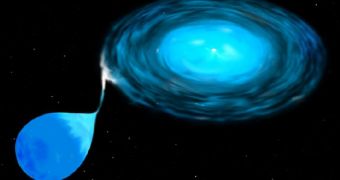The idea stating that black hole growth is somehow linked to the dark matter halos around and within massive galaxies is starting to get additional evidence. However, the connection is still feeble, and only a limited number of studies have been conducted on the issue.
This line of study was prompted by the fact that the most massive black holes in the Universe were discovered to lie in massive galaxies, which contain the most impressive dark matter halos ever found.
Researchers then naturally began wondering whether some kind of exotic physics was at work in these cases, connecting the two objects through an invisible link, that was not immediately made apparent.
In order to test the connection, experts from the Max Planck Institute of Extraterrestrial Physics and the University Observatory Munich, in Germany, and the University of Texas in Austin (UTA), in the United States, decided to join forces.
They set out to demonstrate that the overall mass of a black hole has nothing to do with the amount of dark matter that can be found in a particular halo. What they wanted to demonstrate was that the size of the galactic bulge is the main factor influencing the growth of the dark behemoth.
According to astrophysicists, each and every galaxy lies within a huge halo of dark matter, which extends a lot farther than the visible limits of the galaxy. This halo dominates the galaxy's total mass.
Though older studies suggested that the growth of black holes was correlated with the growth of the galactic bulge, rather than the movements of its dark matter halo-dominated outer disk, a new series of studies published in 2002 proposed the latter connection anew.
The collaboration basically set out to demonstrate that the proposals were untrue. After conducting high-quality spectral observations of numerous disk, bulge and pseudo-bulge galaxies, the team established no correlation between dark matter halos and black holes.
“It is hard to conceive how the low-density, widely distributed non-baryonic dark matter could influence the growth of a black hole in a very tiny volume deep inside a galaxy,” explains Ralf Bender.
The expert holds joint appointments at the Max Planck Institute for Extraterrestrial Physics and the University Observatory Munich. “It seems much more plausible that black holes grow from the gas in their vicinity, primarily when the galaxies were forming,” adds UTA astronomer John Kormendy.
One of the mechanisms through which black holes grow to their impressive sizes is galactic mergers, which occur when two galaxies collide, and then become one. This stirs up settled hydrogen gas reserves, and rekindles stellar nurseries.
Some of the newly-formed stars are gobbled up by the central black hole, which continues to grow, Daily Galaxy reports.

 14 DAY TRIAL //
14 DAY TRIAL //